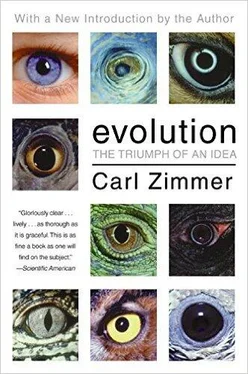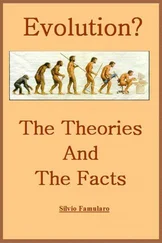In the natural world, evolution favors organisms that can turn their food into proteins that help them reproduce more successfully. Adami created a similar system of rewards for his digital organisms in Avida. He set up a list of tasks for the organisms to perform, such as reading a number and transforming it into its opposite, so that 10101 becomes 01010. If an organism evolves the ability to do this, he rewards it by speeding up the rate at which its program runs. With a faster-running program, a digital organism can replicate faster. And the rewards for carrying out more complex operations are bigger than for carrying out simpler ones. This reward system radically changes the direction of evolution in Avida. Instead of becoming stripped-down virus-like organisms, the organisms evolve into sophisticated data processors.
Avida is essentially evolving new pieces of software, although they are unlike any program written by a human being. The alien structure of Avida’s programs has attracted the attention of Microsoft, which has funded some of Adami’s research. They recognize that our DNA is in some ways like an extraordinary computer program, but it can keep a trillion-cell human body going for 70 years without crashing. There seems to be something about the way that evolution produces information processing that makes it more robust than human creations. Microsoft would like to know whether they might someday be able to evolve software rather than write it. The programs that evolve inside Avida today are as simple compared to a spreadsheet as bacteria are to a blue whale. Yet evolution has produced blue whales, and it’s conceivable that in an artificial world like Avida, it might be able to produce spreadsheets as well. The challenge will be to landscape the evolutionary hills and valleys of artificial life in the right way, so that a spreadsheet design represents the highest peak of fitness.
Avida is part of an infant science, known as evolutionary computing. Its disciples are discovering that natural selection can shape not only software but hardware as well. A computer can be challenged to come up with thousands of different designs for a device, which it can then test in a simulation. The ones that run best are saved, and then randomly altered in small ways to create a new generation of designs. Without any more guidance than this, computers can evolve some extraordinary inventions.
In 1995, for instance, the engineer John Koza used evolutionary computing to design a low-pass filter, a device that can cut off sounds above a certain frequency. Koza chose 2,000 cycles a second as his cutoff. After 10 generations, his computer produced a circuit that muffled frequencies above about 500 cycles and only completely extinguished them above about 10,000. After 49 generations, it had created a circuit that produced a sharp drop-off at 2,000 cycles. Natural selection had created a design for a seven-rung ladder made out of inductors and capacitors. The same design had been invented in 1917 by George Campbell of AT&T. The computer, without any direction from Koza, had infringed on a patent.
Since then, Koza and others have evolved thermometers, amplifiers complete with woofers and tweeters, circuits that control robots, and dozens of other devices, many of which replicate the work of great inventors. It won’t be long, they predict, before evolutionary computing will create devices that warrant patents of their own.
For the moment, this kind of evolution remains trapped inside computers, dependent on human programmers and engineers for its existence. But within a few decades, independent robots may be able to evolve on their own, transforming themselves into new forms that humans could never imagine. In a sign of things to come, Hod Lipson and Jordan Pollack, two engineers at Brandeis University in Massachusetts, announced in August 2000 that they had programmed a computer to use evolution to design a walking robot.
Lipson and Pollack’s computer evolved 200 robot designs, each starting completely from scratch. Using a simulation program, Lipson and Pollack scored the robots by how fast they could move across the floor, replaced low-fitness robot designs with ones of higher fitness, and mutated all the remaining robots again. After several hundred generations, the computer then built some of the most successful robots out of molded plastic. These evolved robots walk like inchworms, crabs, and other real animals, yet they look unlike any real animal (or, for that matter, the animal-like robots that humans have built).
The dawn of artificial evolution is a triumph Darwin could not have imagined. Four billion years ago, a new form of matter emerged on this planet: a substance that could store information and replicate itself, that could survive as that information gradually changed. We humans are made of that mutable stuff, but we may now be carrying its laws into new forms, into silicon and plastic, into binary streams of energy.
PART TWO
Creation and Destruction
Five
Rooting the Tree of Life
From Life’s Dawn to the Age of Microbes
Natural selection is not unique to guppies in Trinidad or finches on the Galápagos Islands. It is at work on all species everywhere on the planet, and it has been at work ever since life first emerged. Scientists have traced life back at least 3.85 billion years, and the fossil record now reveals the emergence of new forms of life—eukaryotes, animals and plants, fish, reptiles and mammals—in the eons that have passed since. Generation upon generation of evolution transformed those earliest organisms into all the new forms that came afterward.
Darwin was never eager to speculate on how these great transformations took place. The natural selection taking place in his own day was enough of a puzzle for him, unable as he was to comprehend heredity. But now enough evidence is emerging—in the form of gene sequences, fossils, and ancient traces of Earth’s chemistry—to let scientists begin deciphering the evolution of life. In the process, today’s evolutionary biologists are pushing beyond the limits of the modern synthesis, discovering that evolution’s reign has been quirkier and more remarkable than previous generations could have guessed.
The Tree of Life
The history of life has not unspooled as a simple line. As Darwin proposed, it has grown like a tree over time, as new species have branched off from old ones. Most of those branches have been pruned by extinction, but not before they gave rise to life as we see it around us on Earth today.
Scientists have been drawing and redrawing the tree of life for decades. At first they could only compare different species by looking at their anatomy, such as the sutures of skulls and the twists of wombs. But this method failed when scientists tried to step back and look at life on its broadest scale. You can compare elm leaves to the leaves of maples or pines, but there are no leaves on humans to compare them with. Fortunately, elms and humans are both based on DNA. By sequencing snippets of genetic material from hundreds of species, ranging from frogs to yeast to cyanobacteria, scientists over the past 25 years have assembled the tree of life.
This tree is not an icon, but a scientific hypothesis. It offers the simplest interpretation of the genetic sequences that scientists have studied, how genes have mutated from one form to another. As new species are discovered and new genes are sequenced, the simplest interpretation may demand that some of the branches be rearranged. Now scientists are able to compare the entire genomes of hundreds of species.
This tree is a strange thing to behold. In the late nineteenth century, evolutionary biologists drew the tree of life as if it were a mighty oak, with branches coming off a main trunk. The simplest organisms such as bacteria sprouted near its base, and humanity was placed at its very crown, the pinnacle of evolution. But instead of a single shaft of evolution ever ascending, scientists now see life splayed out into an unruly thicket.
Читать дальше












